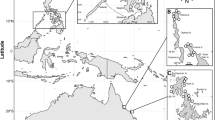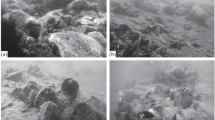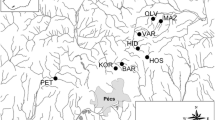Abstract
The gastropods Lepetodrilus fucensis and Depressigyra globulus are abundant faunal components of animal communities at deep-sea hydrothermal vents along the Juan de Fuca Ridge in the NE Pacific. The population structure and recruitment pattern of both species were studied using modal decomposition of length–frequency distributions. Gastropod populations were collected from Axial Volcano and Endeavour Segment in 2002 and 2003. Polymodal size–frequency distributions, particularly at Axial Volcano vent sites, suggest a discontinuous recruitment pattern for D. globulus. In contrast, there were no distinct peaks visible in the distributions of L. fucensis, suggesting a continuous recruitment pattern for this species. For both species, distributions were positively skewed towards the smaller length–classes, implying post-settlement mortality is high. However, variations in growth, due to short- and long-term variability in environmental conditions in the hydrothermal vent habitat, as well as biological interactions, may also be influencing the distribution and abundance of subsequent life-history stages. Using maximum shell lengths from populations of known ages, the growth rate of L. fucensis was estimated as 9.6 μm day−1, indicating adulthood would be reached in ∼1 year. Our results suggest that, despite occupying the same habitat, abundance and population structure are regulated by different biotic and abiotic processes in L. fucensis and D. globulus.







Similar content being viewed by others
References
Bates A (2006) Population and feeding characteristics of hydrothermal vent gastropods along environmental gradients with a focus on a bacterial symbiosis hosted by Lepetodrilus fucensis (Vetigastropoda). Ph D Thesis. Earth and Ocean Sciences, University of Victoria, Victoria, pp 229
Bates AE (2007) Persistence, morphology, and nutritional state of a gastropod hosted bacterial symbiosis in different levels of hydrothermal vent flux. Mar Biol 152:557–568
Bates AE, Tunnicliffe V, Lee RW (2005) Role of thermal conditions in habitat selection by hydrothermal vent gastropods. Mar Ecol Prog Ser 305:1–15
Bergquist DC, Eckner JT, Urcuyo IA, Cordes EE, Hourdez S, Macko SA, Fisher CR (2007) Using stable isotopes and quantitative community characteristics to determine a local hydrothermal vent food web. Mar Ecol Prog Ser 330:49–65
Bhattacharya CG (1967) A simple method of resolution of a distribution into Gaussian components. Biometrics 23:115–135
Booth DJ, Brosnan DM (1995) The role of recruitment dynamics in rocky shore and coral reef fish communities. Adv Ecol Res 26:309–389
Boss KJ, Turner RD (1980) The giant white clam from Galapagos Rift, Calyptogena magnifica species novum. Malacologia 20:161–194
Chevaldonne P, Desbruyeres D, Le Haitre M (1991) Time-series of temperature from three deep-sea hydrothermal vent sites. Deep Sea Res 38:1417–1430
Comtet T, Desbruyeres D (1998) Population structure and recruitment in mytilid bivalves from the Lucky Strike and Menez Gwen hydrothermal vent fields (37°17′N and 37°50′N on the Mid-Atlantic Ridge). Mar Ecol Prog Ser 163:165–177
Connell JH (1961) The influence of interspecific competition and other factors on the distribution of the barnacle Cthamalus stellatus. Ecology 42:710–723
Connell JH (1985) The consequences of variation in initial settlement vs. post-settlement mortality in rocky intertidal communities. Mar Biol Ecol 93:11–45
de Burgh ME, Singla CL (1984) Bacterial colonization and endocytosis on the gill of a new limpet species from a hydrothermal vent. Mar Biol 84:1–6
Du J (2002) Combined algorithms for constrained estimation of finite mixture distributions with grouped data and conditional data. M Sc Thesis. Mathematics and Statistics, McMaster University, Hamilton, pp 121
Embley R, Baker E (1999) Interdisciplinary group explores seafloor eruption with remotely operated vehicle. Eos 80:213–228
Embley RW, Chadwick WW Jr, Clague D, Stakes D (1999) 1998 Eruption of Axial Volcano: multibeam anomalies and sea-floor observations. Geophys Res Lett 26:3425–3428
Gage JD (1995) Demographic modelling in the analysis of population dynamics of deep-sea macrobenthos. Int Revue Ges Hydrobiol 80:171–195
Gage JD, Tyler PA (1982) Growth and reproduction of the deep-sea brittlestar Ophiomusium lymani Wyville Thompson. Oceanol Acta 5:73–83
Girguis PR, Childress JJ (2006) Metabolite uptake, stoichiometry and chemoautotrophic function of the hydrothermal vent tubeworm Riftia pachyptila: responses to environmental variations in substrate concentrations and temperature. J Exp Biol 209:3516–3528
Gosselin LA, Qian P-Y (1997) Juvenile mortality in benthic marine invertebrates. Mar Ecol Prog Ser 146:265–282
Grant A, Morgan PJ, Olive PJW (1987) Use made in marine ecology of methods for estimating demographic parameters from size/frequency data. Mar Biol 95:201–208
Gray DR, Hodgson AN (2003) Growth and reproduction in the high-shore South African limpet Helcion pectunculus (Mollusca: Patellogastropoda). Afr Zool 38:371–386
Gulland JA, Rosenberg AA (1992) A review of length-based approaches to assessing fish stocks. FAO Fisheries Technical Paper, Rome, pp 100
Hourdez S, Lallier FH (2007) Adaptations to hypoxia in hydrothermal-vent and cold-seep invertebrates. Rev Environ Sci Biotechnol 6:143–159
Hunt HL, Scheibling RE (1997) Role of early post-settlement mortality in recruitment of benthic marine invertebrates. Mar Ecol Prog Ser 155:269–301
Hutchinson N, Williams GA (2001) Spatio-temporal variation in recruitment on a seasonal, tropical rocky shore: the importance of local versus non-local processes. Mar Ecol Prog Ser 215:57–68
Jannasch HW (1995) Microbial interactions with hydrothermal fluids Seafloor hydrothermal systems: physical, chemical, biological, and geological interactions. American Geophysical Union, pp 273–296
Jarrett JN (2000) Temporal variation in early mortality of an intertidal barnacle. Mar Ecol Prog Ser 204:305–308
Jenkins SR, Hartnoll RG (2001) Food supply, grazing activity and growth rate in the limpet Patella vulgata L.: a comparison between exposed and sheltered shores. J Exp Mar Biol Ecol 258:123–139
Johnson KS, Beehler CL, Sakamoto-Arnold CM, Childress JJ (1986) In situ measurements of chemical distributions in a deep-sea hydrothermal vent field. Science 231:1139–1141
Johnson KS, Childress JJ, Beehler CL (1988a) Short-term temperature variability in the Rose Garden hydrothermal vent field: an unstable deep-sea environment. Deep Sea Res 35:1711–1721
Johnson KS, Childress JJ, Hessler RR, Sakamoto-Arnold CM, Beehler CL (1988b) Chemical and biological interactions in the Rose Garden hydrothermal vent field, Galapagos spreading center. Deep Sea Res 35:1723–1744
Jollivet D, Empis A, Baker MC, Hourdez S, Comtet T, Jouin-Toulmond C, Desbruyeres D, Tyler PA (2000) Reproductive biology, sexual dimorphism, and population structure of the deep sea hydrothermal vent scale-worm, Branchipolynoe seepensis (Polychaeta: Polynoidae). J Mar Biol Assoc UK 80:55–68
Jones ML (1985) On the Vestimentifera, new phylum: six new species, and other taxa, from hydrothermal vents and elsewhere. Bull Biol Soc Wash 6:117–158
Kelly NE, Metaxas A (2007) Influence of habitat on the reproductive biology of the deep-sea hydrothermal vent limpet Lepetodrilus fucensis (Vetigastropoda: Mollusca) from the Northeast Pacific. Mar Biol 151:649–662
Kelly NE, Metaxas A, Butterfield DA (2007) Spatial and temporal patterns in colonization by deep-sea hydrothermal vent invertebrates on the Juan de Fuca Ridge, NE Pacific. Aquat Biol 1:1–16
Kido JS, Murray SN (2003) Variation in owl limpet Lottia gigantea population structures, growth rates, and gonadal production on southern California rocky shores. Mar Ecol Prog Ser 257:111–124
Lee RW (2003) Thermal tolerances of deep-sea hydrothermal vent animals from the Northeast Pacific. Biol Bull 205:98–101
Little SA, Stolzenbach KD, Grassle FJ (1988) Tidal current effects on temperature in diffuse hydrothermal flow: Guaymas Basin. Geophys Res Lett 15:1491–1494
Lutz RA, Fritz LW, Rhoads DC (1985) Molluscan growth at deep-sea hydrothermal vents. Biol Soc Wash Bull 6:199–210
Lutz RA, Shank TM, Fornari DJ, Haymon RM, Lilley MD, Von Damm KL, Desbruyeres D (1994) Rapid growth at deep-sea vents. Nature 371:663–664
MacDonald PDM, Pitcher TJ (1979) Age-groups from size-frequency data: a versatile and efficient method of analyzing distribution mixtures. Can J Fish Aquat Sci 36:987–1001
Marcus J (2003) Community ecology of hydrothermal vents at Axial Volcano, Juan de Fuca Ridge, Northeast Pacific. Ph D thesis. Department of Biology, University of Victoria, Canada, pp 278
McHugh D (1989) Population structure and reproductive biology of two sympatric hydrothermal vent polychaetes, Paralvinella pandorae and P. palmiformis. Mar Biol 103:95–106
McHugh D, Tunnicliffe V (1994) Ecology and reproductive biology of the hydrothermal vent polychaete Amphisamytha galapagensis (Ampharetidae). Mar Ecol Prog Ser 106:111–120
McLean JH (1988) New archaeogastropod limpets from hydrothermal vents; superfamily Lepetodrilacea I. Systematic descriptions. Philos Trans R Soc Lond B Biol Sci 319:1–32
Menge BA (1991) Relative importance of recruitment and other causes of variation in rocky intertidal community structure. J Exp Mar Biol Ecol 146:69–100
Metaxas A (2004) Spatial and temporal patterns in larval supply at hydrothermal vents on the northeast Pacific Ocean. Limnol Oceanogr 49:1949–1956
Micheli F, Peterson CH, Mullineaux LS, Fisher CR, Mills SW, Sancho G, Johnson GA, Lenihan HS (2002) Predation structures communities at deep-sea hydrothermal vents. Ecol Monogr 72:365–382
Minchinton TE, Scheibling RE (1991) The influence of larval supply and settlement on the population structure of barnacles. Ecology 72:1867–1879
Mullineaux LS, Mills SW, Goldman E (1998) Recruitment variation during a pilot colonization study of hydrothermal vents. Deep Sea Res II 45:441–464
Raimondi PT (1990) Patterns, mechanisms, consequences of variability in settlement and recruitment of an intertidal barnacle. Ecol Monogr 60:283–309
Rhoads DC, Lutz RA, Revelas EC, Cerrato RM (1981) Growth of bivalves at deep-sea hydrothermal vents along the Galapagos Rift. Science 214:911–913
Roux M, Rio M, Fatton E (1985) Clam growth and thermal spring activity recorded by shells at 21°N. Bull Biol Soc Wash 6:211–221
Sadosky F, Thiebaut E, Jollivet D, Shillito B (2002) Recruitment and population structure of the vetigastropod Lepetodrilus elevatus at 13°N hydrothermal vent sites on East Pacific Rise. Cah Biol Mar 43:399–402
Sarrazin J, Juniper SK (1999) Biological characteristics of a hydrothermal edifice mosaic community. Mar Ecol Prog Ser 185:1–19
Sarrazin J, Robigou V, Juniper SK, Delaney JR (1997) Biological and geological dynamics over 4 years on a high-temp sulfide structure at the Juan de Fuca Ridge hydrothermal observatory. Mar Ecol Prog Ser 153:5–24
Southward EC, Tunnicliffe V, Black M (1995) Revision of the species of Ridgeia from Northeast Pacific hydrothermal vents, with a redescription of Ridgeia piscesae Jones (Pogonophora: Obturata = Vestimentifera). Can J Zool 73:282–295
Thiebaut E, Huther X, Shillito B, Jollivet D, Gaill F (2002) Spatial and temporal variations of recruitment in the tube worm Riftia pachyptila on the East Pacific Rise (9°50′N and 13°N). Mar Ecol Prog Ser 234:147–157
Tivey MK, Bradley AM, Joyce TM, Kadko D (2002) Insights into tide-related variability at seafloor hydrothermal vents from time-series temperature measurements. Earth Planet Sci Lett 202:693–707
Tsurumi M, Tunnicliffe V (2003) Tubeworm-associated communities at hydrothermal vents on the Juan de Fuca Ridge, northeast Pacific. Deep Sea Res I 50:611–629
Tunnicliffe V, Juniper SK (1990) Dynamic character of the hydrothermal vent habitat and the nature of the sulphide chimney fauna. Prog Oceanogr 24:1–13
Tunnicliffe V, Embley RW, Holden JF, Butterfield DA, Massoth BJ, Juniper SK (1997) Biological colonization of new hydrothermal vents following an eruption on Juan de Fuca Ridge. Deep Sea Res I 44:1627–1644
Tyler PA, Young CM (1999) Reproduction and dispersal at vents and cold seeps. J Mar Biol Assoc UK 79:193–208
Urcuyo IA, Massoth GJ, Julian D, Fisher CR (2003) Habitat, growth and physiological ecology of a basaltic community of Ridgeia piscesae from the Juan de Fuca Ridge. Deep Sea Res I 50:763–780
Van Dover CL, Factor JR, Williams AB, Berg CJ Jr (1985) Reproductive patterns of decapod crustaceans from hydrothermal vents. Biol Soc Wash Bull 6:223–227
Van Dover CL, Berg CJ Jr, Turner RD (1988) Recruitment of marine invertebrates to hard substrates at deep-sea hydrothermal vents on the East Pacific Rise and Galapagos spreading center. Deep Sea Res 35:1833–1849
Voight JR (2000) A deep-sea octopus (Graneledone cf. boreopacifica) as a shell-crushing hydrothermal vent predator. J Zool Soc Lond 252:335–341
Waren A, Bouchet P (1989) New gastropods from east Pacific hydrothermal vents. Zool Scrip 18:67–102
Young CM (2003) Reproduction, development and life-history traits. In: Tyler PA (ed) Ecosystems of the deep oceans. Elsevier, Amsterdam, pp 381–426
Zal F, Jollivet D, Chevaldonne P, Desbruyeres D (1995) Reproductive biology and population structure of the deep-sea hydrothermal vent worm Paralvinella grasslei (Polychaeta:Alvinellidae) at 13°N on the East Pacific Rise. Mar Biol 122:637–648
Acknowledgments
We thank the crews of the R/V Thomas G. Thompson, CCGS John P. Tully, and ROPOS for their assistance during deployment and recovery of many sets of basalt blocks. We also thank chief scientists V. Tunnicliffe, K. Juniper, B. Embley, W. Chadwick, and J. Delaney for their patience and willingness to conduct these experiments during cruises with many time constraints. A. Bates, J. Csotonyi, A. Ortmann and G. Yahel helped with block recovery and provided moral support aboard ship. C.T. Taggart generously provided access to his camera and laboratory equipment. M. Beck assisted with gastropod length measurements and R. Wickramanayake assisted with the sorting of suction samples. Finally, we thank R. Scheibling, C. Fisher, and two anonymous reviewers whose comments improved and strengthened this manuscript. This research was supported by NSERC PGS D and Izaak Walton Killam Memorial Scholarships to N.K., and NSERC Discovery and CRO grants to A.M.
Author information
Authors and Affiliations
Corresponding author
Additional information
Communicated by R. Cattaneo-Vietti.
Rights and permissions
About this article
Cite this article
Kelly, N.E., Metaxas, A. Population structure of two deep-sea hydrothermal vent gastropods from the Juan de Fuca Ridge, NE Pacific. Mar Biol 153, 457–471 (2008). https://doi.org/10.1007/s00227-007-0828-4
Received:
Accepted:
Published:
Issue Date:
DOI: https://doi.org/10.1007/s00227-007-0828-4




